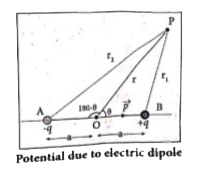Derive an expression for electrostatic potential due to an electric dipole.
(i) AB be the electric dipole ( -q at A tna +q at B).
2a be the distance between -q and +q.
.r. be the distance between the point .p. and mid point .O. of AB.
.θ. be the angle between OP and OB.

(ii) Let r1 be the distance of point P from +q and r2 be the distance of point P from -q.
Potential at P due to charge +q =14πε0qr1
Potential at P due to charge -q =−14πε0qr2
Total potential at the point p,
V=14πε0q(1r1−1r2) ....(1)
(iii) By the cosine law for triangle BOP.
r21=r2+a2−2racosθ
r21=r2(1+a2r2−2arcosθ)
Since a a<<r, term a2r2 is very small and can be neglected. Therefore
r21=r2(1−2acosθr)
(or) r1=r(1−2arcosθ)12
1r1=1r(1−2arcosθ)12
(iv) Using binamial theorem we get.
1r1=1r(1+arcosθ) ...(2)
Similarly applying the cosne law for triangle AOP,
r22=r2−a2−2racos(180−θ)
Since cos (180−θ) = −cosθ we get
r22=r2+a2+2racosθ
Neglecting a2r2 ( because r>>a )
a22=r2(1+2acosθr)
r2=r(1+2acosθr)12
Using Binomial theorem we get
1r2=1r(1−acosθr) ...(3)
Substituting equation (3) and (2) in equation (1),
V=14πε0q(1r(1+acosθr)−1r(1−acosθr))
V=q4πε0(1r(1+acosθr)−1r(1−acosθr))
V=14πε02aqr2cosθ
(v) But the electric dipole moment p = 2qa and we get,
V=14πε0(pcosθr2)
If p cosθ=→p⋅ˆr, where ˆr is the unit vector from the point O to point P. then
V=14πε0→p⋅ˆrr2 (r>>a) ...(4)
Spacial cases
Case (i) If the point P lies on the axial line then θ=0, then
v=14πε0pr2 ...(5)
Case (ii) If the point P lien on the axial line then θ=180∘, then
V=14πε0pr2 ...(6)
Case (iii) If the point P lies on the equatorial line, then θ=90∘. Hence
V = 0 ...(7)
Similar Questions
Deduce an expression for the electric potential due to an electric dipole at any point on its axis. Mention one contrasting feature of electric potential at a point due to dipole as compared to that due to a single charge.
View SolutionDeduce an expression for the electric potential due to an electric dipole at any point on its axis. Mention one contrasting feature of electric potential of a dipole at a point as compared to that due to a single charge.
View SolutionWhat is an electric dipole and electric dipole moment? Derive an expression for electric potential at any point due to an electric dipole. Also discuss the special cases.
View SolutionPotential Due To And Electric Dipole
View SolutionDerive an expression for the potential energy of an electric dipole of dipole moment →p in an electric field →E.
View SolutionDerive an expression for potential energy of an electric dipole in a uniform electric field. In which situation, the potential energy fo dipole is (i) maximum and (ii) minimum.
View Solution(i) Derive the expression for the specific for the electric potential due to an electric dipole at a point on its axial line.
(ii) Depiet the equivpotential surfaces due to an electric dipole.
View SolutionDefine electrostatic potential energy. Obtain an expression for electrostatic potential at a point on the equatorial line of an electric dipole.
View SolutionDerive an expression for the work done in rotating an electric dipole from its equilibrium position to an angle θ with the uniform electrostatic field.
View SolutionDerive an expression for the electric potential at any point along the axial line of an electric dipole.
View Solution
